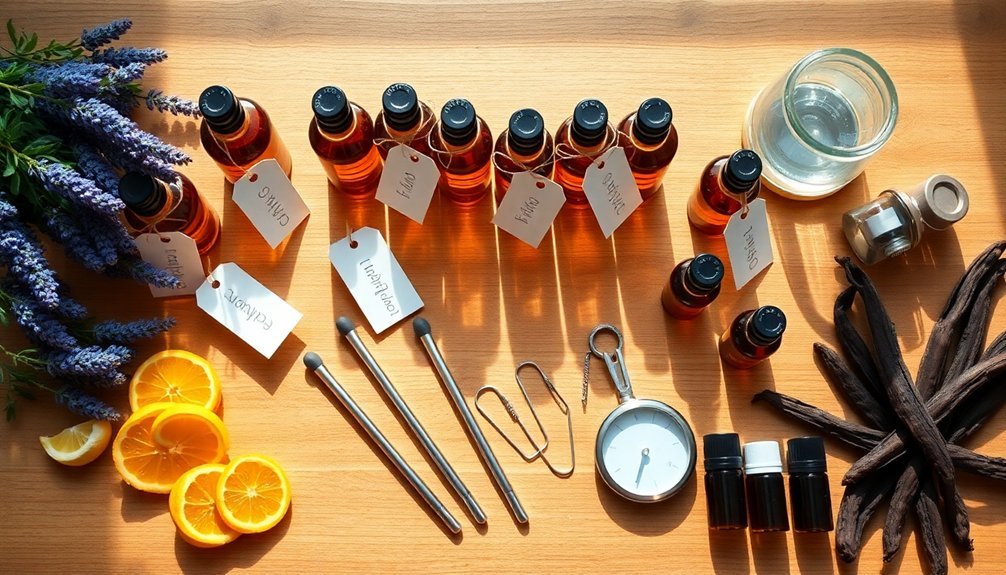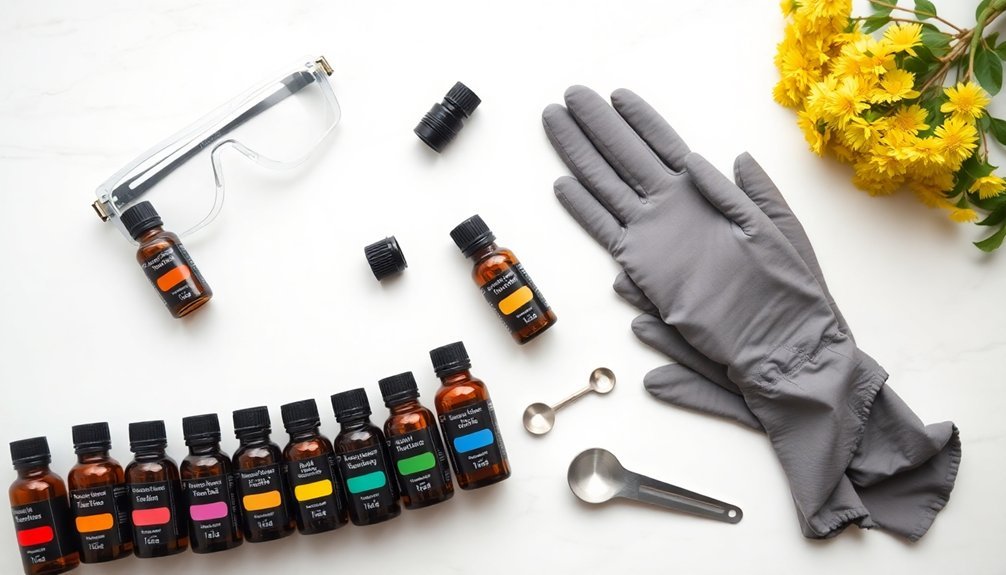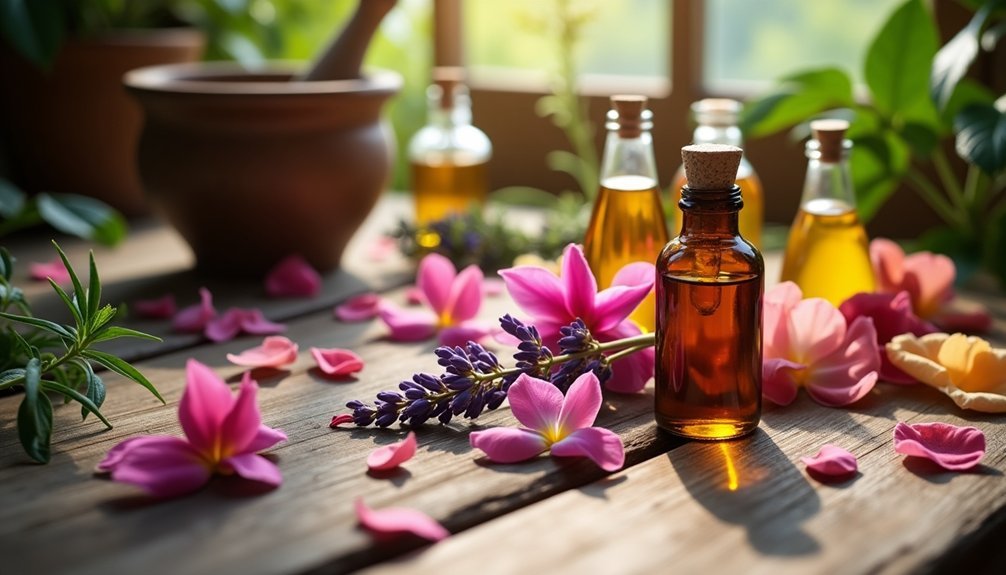To start making organic perfumes, you'll need essential measuring tools like digital scales and glass cylinders, plus basic blending equipment including spatulas, beakers, and droppers. Stock up on natural ingredients such as essential oils, carrier oils, and fixatives like beeswax. Don't forget safety gear – nitrile gloves, goggles, and a lab coat are must-haves. For the best results, invest in dark glass storage bottles and natural preservatives. The journey to creating your signature scent awaits below.
Essential Equipment for Your Perfume Making Station

When setting up your perfume making station, you'll need specialized equipment to confirm precise measurements and proper handling of ingredients.
Start with measuring tools like digital scales, glass cylinders, and measuring spoons to assure accuracy in your formulations. A metal spatula set is crucial for precise portioning of solid and waxy materials.
You'll require transferring tools including pipettes, glass bowls, and stirring rods for mixing ingredients. A magnetic stirrer can help blend your creations efficiently.
For storage, invest in dark glass containers to protect your oils and elegant bottles for your final products.
Don't forget safety equipment – gloves, safety glasses, and protective masks are essential.
You'll also need fragrance blotters for testing scents and a notebook to record your recipes.
Complete your setup with funnels for filling bottles and adhesive labels to organize your ingredients.
Natural Ingredients and Raw Materials
As you begin creating organic perfumes, you'll need a carefully selected collection of natural ingredients that serve as your aromatic building blocks. Start with essential oils like lavender and bergamot for their pure, concentrated scents. Add depth using herbs and flowers such as rose petals and chamomile, which can be infused into carrier oils. Creating your own perfume allows you to develop personal signature scents that reflect your unique preferences.
| Base Materials | Natural Fixatives | Aromatic Enhancers |
|---|---|---|
| Coconut Oil | Beeswax | Ylang Ylang |
| Jojoba Oil | Resins | Patchouli |
| Sweet Almond Oil | Gums | Absolutes |
Don't forget to include natural fixatives that'll help your fragrances last longer. Beeswax and resins like benzoin work well for solid perfumes, while carrier oils such as jojoba and sweet almond create perfect bases for liquid formulations. You can also explore tinctures and absolutes for more complex scent profiles.
Safety Gear and Protective Equipment

Since working with essential oils and chemicals requires proper protection, you'll need specific safety equipment before starting your organic perfume journey.
Start with high-quality nitrile gloves and safety goggles to protect your hands and eyes from accidental splashes. You'll also need a lab coat or apron to shield your clothing and skin from potential spills.
Make sure your workspace is well-ventilated, and keep a fire extinguisher nearby. Regular mask inspections are essential to ensure continued protection against hazardous vapors.
Install an eye wash station and have easy access to emergency shower facilities. You'll need a mask or respirator when working with strong-smelling materials or volatile compounds.
Keep safety data sheets (SDS) for all your ingredients readily available, and familiarize yourself with emergency procedures before handling any materials.
Measuring and Blending Tools
To create professional organic perfumes, you'll need precise measuring tools and reliable blending equipment. Start with a digital scale that measures in tenths or hundredths of a gram, and gather essential borosilicate beakers and graduated cylinders for accurate volume measurements.
Don't forget a conductivity meter to monitor essential oil saturation in alcohol.
For blending, you'll want stainless steel funnels and strainers, plus wax-carving tools for handling thick aromatics. A mixer with Teflon bars guarantees contamination-free blending, while an offset spatula helps with smaller quantities.
Set up your workspace with a stainless steel tray and glass beakers for combining ingredients. Keep pipettes, fragrance tester strips, and a perfume journal nearby for precise measurements and detailed documentation of your creations.
Storage Containers and Bottles

When creating organic perfumes, proper storage containers protect your valuable formulas from degradation and contamination.
You'll need high-quality glass or plastic containers with tight-fitting lids and UV protection. Choose 16-ounce Boston Round bottles or similar containers with wide mouths for easy access to your formulas.
Organize your storage system using tiered racks and color-coded labels. Place small round stickers on container lids for quick identification, and maintain a catalog of your ingredients.
You'll want to separate natural and synthetic materials into different sections. Store your containers in a cool, dark place, using plastic A4 paper boxes as convenient storage solutions.
Keep frequently used ingredients within easy reach, and remember to rotate your stock to maintain freshness. Don't store perfume materials near food items to prevent cross-contamination.
Organic Base Oils and Carriers
When starting your organic perfume journey, you'll need several fixed oils that can serve as reliable carriers for your essential oil blends.
Your selection should focus on versatile, skin-compatible options like jojoba, sweet almond, or grapeseed oil, which maintain fragrance integrity while offering beneficial properties.
Store your carrier oils in dark glass bottles away from direct sunlight and heat to preserve their freshness and extend their shelf life.
Fixed Oil Selection Guide
The foundation of any organic perfume begins with selecting the right carrier oils.
You'll want to take into account five main options, each offering unique benefits for your creations.
Jojoba oil serves as an excellent all-around choice, mimicking your skin's natural oils while maintaining fragrance integrity.
Sweet almond oil provides a light, nourishing base that's gentle on sensitive skin.
If you're seeking a non-greasy option, fractionated coconut oil offers easy blending and stays liquid at any temperature.
Grapeseed oil's neutral scent makes it perfect for letting your fragrances shine through, while apricot kernel oil adds a luxurious touch that reveals scent notes gradually.
For best results, start with a 2% dilution ratio – about 15 drops of essential oil per ounce of carrier oil.
Natural Solvent Best Practices
Selecting natural solvents for organic perfumery requires understanding their unique properties and interactions. You'll want to focus on four main options: ethyl alcohol, isopropyl myristate (IPM), CO2 extraction, and ethyl acetate. Each solvent serves different purposes in your formulations.
| Solvent | Best Use | Key Benefit |
|---|---|---|
| Ethyl Alcohol | Fine fragrances | Rapid evaporation |
| IPM | Oil-based blends | Enhanced stability |
| CO2 Extraction | Delicate plant oils | Preserves compounds |
When choosing your solvent, consider these factors: polarity for proper dissolution, evaporation rate for scent distribution, and stability for long-term preservation. For beginners, start with organic ethyl alcohol as your primary solvent – it's versatile and compatible with most fragrance ingredients. Use IPM for oil-based formulations, and consider CO2 extracts for pure, high-quality botanical essences.
Carrier Oil Storage Tips
Proper carrier oil storage directly impacts the success of your organic perfume formulations.
You'll want to store your oils in dark glass bottles, keeping them in a cool, stable environment away from bathrooms and direct light. For oils with shorter shelf lives, like hemp, grape seed, and rosehip seed, consider refrigeration or freezing to extend their longevity.
- Transfer oils to smaller containers to minimize oxygen exposure and reduce headspace
- Add natural preservatives like vitamin E or rosemary extract to prevent rancidity
- Keep detailed records of storage dates and any changes in oil quality
- Let refrigerated or frozen oils return to room temperature naturally before use
Don't forget to use tight-sealing caps and test small amounts on your skin before incorporating oils into your perfume blends.
Natural Preservatives and Fixatives
You'll need several natural fixatives and preservatives to guarantee your organic perfumes maintain their scent profile and stability over time.
Essential gum resins like myrrh and labdanum serve as excellent fixatives, while natural essential oil fixers such as vanilla and tonka bean absolute help anchor your fragrance compositions.
Though less commonly used today, traditional animal-based stabilizing compounds like ambergris and civet can still be sourced ethically for those seeking to explore historical perfumery methods.
Essential Gum Resins
Natural gum resins serve as both preservatives and fixatives in organic perfumery, making them essential ingredients for any beginner's supply list.
You'll want to start with classic options like benzoin, frankincense, myrrh, and labdanum, which help your fragrances last longer while adding depth to your creations.
When working with gum resins, keep these key points in mind:
- They're soluble in alcohol but not water, so they work perfectly in alcohol-based perfumes.
- You'll need just small amounts to achieve effective fixation.
- Most resins start melting around 80°C (176°F), so store them in a cool place.
- Their properties can vary based on origin, so it's worth experimenting with different sources.
These ancient ingredients remain invaluable in modern perfumery, offering both practical benefits and luxurious aromatic qualities.
Natural Essential Oil Fixers
Essential oil fixatives play an essential role in creating long-lasting organic perfumes by anchoring volatile fragrance molecules and extending their wear time.
You'll want to start with patchouli and vetiver oils, as they're excellent base notes that provide depth and longevity to your blends.
For a luxurious touch, incorporate sandalwood and frankincense oils, which not only fix your fragrances but also add warm, resinous undertones.
Cedarwood oil is perfect for stabilizing lighter notes with its balsamic character.
When working with these fixatives, you'll also need natural preservatives to maintain your perfume's quality.
Consider using citric acid or Geogard ECT for broad-spectrum protection.
If you're creating water-based formulations, propylene glycol works well as an antimicrobial agent while enhancing the overall stability of your organic perfume.
Animal-Based Stabilizing Compounds
While modern perfumery has largely moved away from animal-derived ingredients, understanding these traditional compounds provides valuable context for organic perfume making. These natural fixatives have historically been prized for their ability to stabilize scents and add unique depth to fragrances.
- Natural musk from male deer offers powerful fixative properties, though it's now typically replaced by synthetic alternatives like Galaxolide.
- Ambergris, sourced from sperm whales, excels at preserving fragrance longevity and is now replicated through Ambroxan.
- Civet secretions contribute distinctive musky notes while acting as effective stabilizers.
- Hyraceum, derived from petrified Cape hyrax excretions, provides complex, animalic undertones and fixing properties.
You'll find most modern organic perfumers opt for plant-based alternatives like orrisroot, which offer similar stabilizing benefits without ethical concerns.
Testing and Evaluation Materials
Creating professional perfumes requires specific tools and materials for proper testing and evaluation.
You'll need fragrance tester strips or unbleached coffee filters cut into thin strips, along with small beakers and precise pipettes for measuring oils.
Keep a glass of vodka or grain alcohol handy for cleaning your pipettes between uses.
To evaluate your creations, you'll want to test each base note individually on scent strips before combining them.
Document your experiments with detailed notes and dates.
For quality control, you'll need to verify the stability of your blends across different conditions.
If you're pursuing organic certification, prepare for USDA verification to guarantee your ingredients meet standards for being free from petrochemicals, solvents, dyes, and pesticides.
Cleaning and Maintenance Supplies

You'll need a thorough set of cleaning supplies to maintain your organic perfume-making workspace, including washcloths, exfoliating body wash, and cleaning solvents for equipment sanitization.
Keep your tools and containers spotless by establishing a daily cleaning routine with dish soap for glassware and isopropyl alcohol for surface disinfection.
Store your cleaning supplies in an organized, accessible manner using airtight containers and clear labels to guarantee quick access during your perfume-making process.
Daily Cleaning Essentials
Maintaining a clean workspace is essential for crafting organic perfumes, and five basic cleaning supplies should always be within reach.
You'll want to keep microfiber cloths handy for wiping surfaces and cleaning delicate equipment, along with an all-purpose cleaner for general sanitizing. Store some dish soap nearby for cleaning bottles and tools, and keep paper towels accessible for quick spills.
- Place a small bucket under your workstation to collect waste and make cleanup easier.
- Keep a spray bottle filled with diluted white vinegar for natural disinfecting.
- Use a soft-bristled brush for cleaning bottle threads and caps.
- Store a hand towel within reach for drying equipment and wiping hands.
These daily cleaning essentials will help you maintain a hygienic workspace and guarantee the purity of your organic perfume creations.
Storage and Sanitization Methods
Proper storage and sanitization methods form the backbone of successful organic perfume making. You'll need a dedicated cool, dark storage space away from bathrooms and heat sources.
Keep a soft microfiber cloth and distilled water on hand for gentle cleaning of bottles and surfaces. Store your perfumes in their original packaging or dark boxes on low-level shelves to prevent accidents.
You'll want to maintain a clean, well-ventilated area free from strong odors to avoid cross-contamination. Track your perfumes' quality in a journal, noting dates and observations.
For daily maintenance, make certain bottle caps are tightly sealed after each use, and avoid excessive shaking. Use paper towels or absorbent materials when handling perfumes, and clean storage areas regularly with a dry cloth to maintain ideal conditions.
Organic Fragrance Extraction Tools
Four essential extraction tools form the foundation of creating organic perfumes at home.
You'll need specialized equipment to effectively extract fragrances while preserving their natural qualities. Each method requires specific tools designed to maintain the integrity of your organic ingredients.
- A steam distillation apparatus with glass or stainless steel components – perfect for extracting essential oils from lavender and geranium while collecting both oil and hydrosol.
- Vacuum low-temperature extraction equipment (5L size for beginners) – ideal for preserving delicate aroma compounds.
- Enfleurage boxes made of wood or metal – great for capturing scents from delicate flowers like jasmine using natural fats.
- Solvent extraction vessels made of compatible materials – necessary if you're planning to work with ethanol-based extractions, though this requires extra safety precautions.
Frequently Asked Questions
How Long Does It Take to Master Basic Perfume-Making Skills?
You'll need about 3-6 months of consistent practice to master basic perfume-making skills. With regular experimentation and dedicated learning, you can grasp fundamental blending techniques and understand essential note combinations.
What Is the Average Shelf Life of Homemade Organic Perfumes?
Your homemade organic perfumes will typically last 1-3 years when stored properly. You'll get the best longevity by keeping them in dark, cool places and using alcohol-based formulas with high-quality essential oils.
Can I Sell My Homemade Organic Perfumes Without Certification?
While you can legally sell homemade perfumes, you'll need to comply with safety regulations, submit proper documentation, and obtain necessary certifications in your region to protect yourself and your customers from liability.
Which Organic Ingredients Are Best for Creating Long-Lasting Scents?
You'll get the longest-lasting organic scents by using resins and absolutes like sandalwood and jasmine. Combine these with essential oils such as patchouli and vetiver for enhanced longevity in your perfumes.
How Much Should I Invest Initially in Organic Perfume-Making Supplies?
You'll need to invest between $10,000-$25,000 for a solid start in organic perfume-making. This covers essential oils, equipment, and basic marketing. If you're starting smaller, aim for at least $5,000 for quality ingredients.
In Summary
You're now equipped with all the essentials to begin your organic perfume-making journey. With your tools, natural ingredients, and safety equipment ready, you'll be able to create unique, chemical-free fragrances right from home. Keep expanding your collection of supplies as you gain experience, and don't forget to maintain detailed notes of your formulations. Start small, experiment often, and let your creativity guide your perfume-making adventure.





Leave a Reply